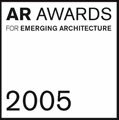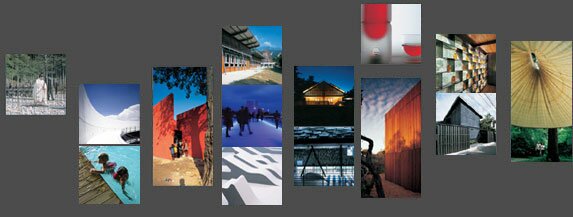

2002
entry conditions 2002
winners 2002
2001
press release 2001
winners 2001
entrants 2001
entrants 2001 pdf
winners comments 2001
2000
winners 2000
the event 2000
1999
winners 1999
ar+d partners worldwide
for your local ar+d representative
architectural review
Buro Happold
|
AMAZING SPECTRUM OF INNOVATIVE DESIGN IN COPENHAGEN The annual international ar+d awards1 were set up by The Architectural Review and d lineTM international as to celebrate the work of young architects and designers who are usually at the start of independent careers and not well known.2 This is the fourth year of the awards, and the jury3 was amazed by the vast variety of artefacts submitted from some 60 countries. They ranged from landscapes to table-ware, temporary installations to churches. Five award winners were chosen from over 700 entries. They were honoured at the Danish Design Centre in Copenhagen on 28 November 2002. Sharing the £ prize money, each received a trophy designed by Knud Holscher. Sean Godsells house in Victoria, Australia was premiated for its thoughtful response to climate and landscape that raises fascinating questions about the nature of modern Australian culture poised between Western and Eastern influences. Archipro Architects cemetery for the unknown dead near Hiroshima, Japan is a moving and abstracted meditation on nature, death and community; it deserved its award for its extremely sensitive response to nature and humanity. The group 3LHD won an award for a pedestrian bridge at Rijeka, Croatia, which besides being an ingenious engineering structure is an important and life-giving complement to the public spaces of the city, and a simple and moving monument to the fallen in the Balkan wars. Marlon Blackwells tiny Honey House in North Carolina was honoured for its great delicacy and thoughtfulness in economic use of materials and for the buildings harmonious relationship to the natural landscape. In complete contrast is the award winning abstracted interior landscape by Jürgen Mayer H. that was first assembled for this years Berlin Congress of the International Union of Architects; it combines ergonomic principles with tectonic sensitivity, practicality with playfulness. The jury selected a further 21 projects for high commendation. While this years jury was perhaps focused on the notion that small is beautiful, infrastructure projects like the daylight-filled Copenhagen metro stations and the marvellous mechanical Millennium Bridge at Gateshead, England were commended. There could be no greater contrast than between the two commended houses, one in Ethiopia, with a structure of living trees, the other on a very small plot in Tokyo, a tiny compact masterpiece of shadows and space. Joyous temporary installations like parasols for a garden party in Munich and a hovering musical analogue in Brisbane contrast with the permanence of a numinous church in Oslo and an expansive chapel in Bogota, Colombia. Buildings for communities range from a womens centre in Senegal to schools in the beautiful tropical forest of Taiwan, a swimming pool programme in Spain to a hall for children in the middle of the Canadian forest. Taming traffic was the theme of two commended schemes: a multi-storey car park in Offenburg, Germany, and a brave little office block in Ljubljana, Slovenia, while intensity of private life is celebrated in a house for meditation in Malacca, Malaysia and an exquisite tea-pot from Canada. Jury chairman Peter Davey commented: The range of artefacts before us was staggering. We were bewildered at first, but consensus on criteria quickly emerged. We were concerned to find invention, tectonic quality, exploration of ideas and respect for the planet. In different ways, all award-winning and commended projects improve the quality of human life. All results are published in full in the December issue of The Architectural Review. Award winning and highly commended schemes will be exhibited at the Royal Institute of British Architects in London during March 2003. Sponsored by Buro Happold, there will be lectures by award winning and highly commended architects during the course of the exhibition. Separate national exhibitions will be held in several countries during the year. For further information contact Peter Davey, The Architectural Review, ; Lonnie H. Kjærgaard, d lineTM international as, ; 1 The Architectural Review has the largest international circulation of any architectural publication in the world. It sells in over 130 countries. Founded in 1896, it has been published continuously ever since. It covers theory, urbanism, landscape, product and interior design as well as buildings d lineTM international as has worked internationally for over 25 years, specialising in work related to the architectural ironmongery market. d line products are designed by Knud Holscher, architect and professor at the Royal Danish Academy. The firms products are distributed in 50 countries This year, the awards were kindly supported by Buro Happold, the international consulting engineers. Buro Happold is a multi-disciplinary international practice of consulting engineers established in 1976 offering civil and structural engineering, mechanical and electrical engineering, quantity surveying, building services and environmental engineering, infrastructure and traffic engineering, ground engineering, facade engineering, fire engineering, computational fluid dynamics analysis, disability design consultancy, project management, urban design and specialist CAD services. Further information and illustrations available from: Helen Elias, ; mobile, 0; 2 All work submitted must be constructed. The age limit of 45 was chosen for entrants because in many countries architects and designers find it difficult to build before that age. 3 Jury Members were Stefan Behnisch (Germany), Margrét Hardardottír (Iceland), Rick Joy (USA), Carme Pinós (Spain) and Hin L. Tan (Malaysia). Peter Davey, Editor of the Architectural Review was chairman. |